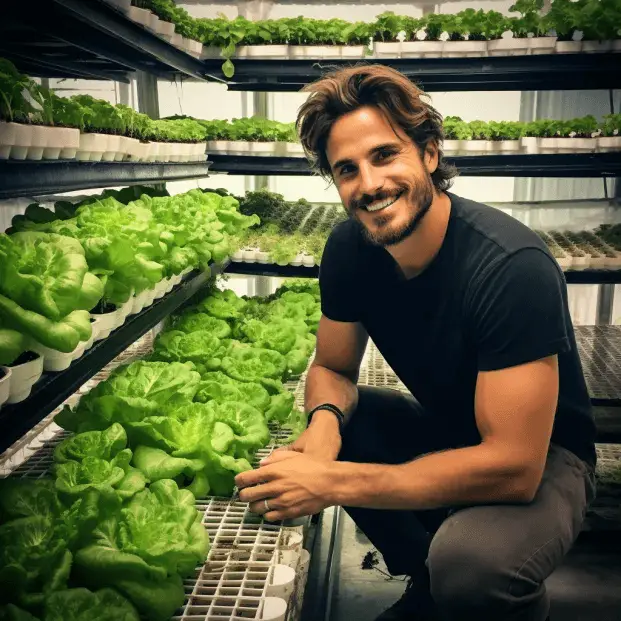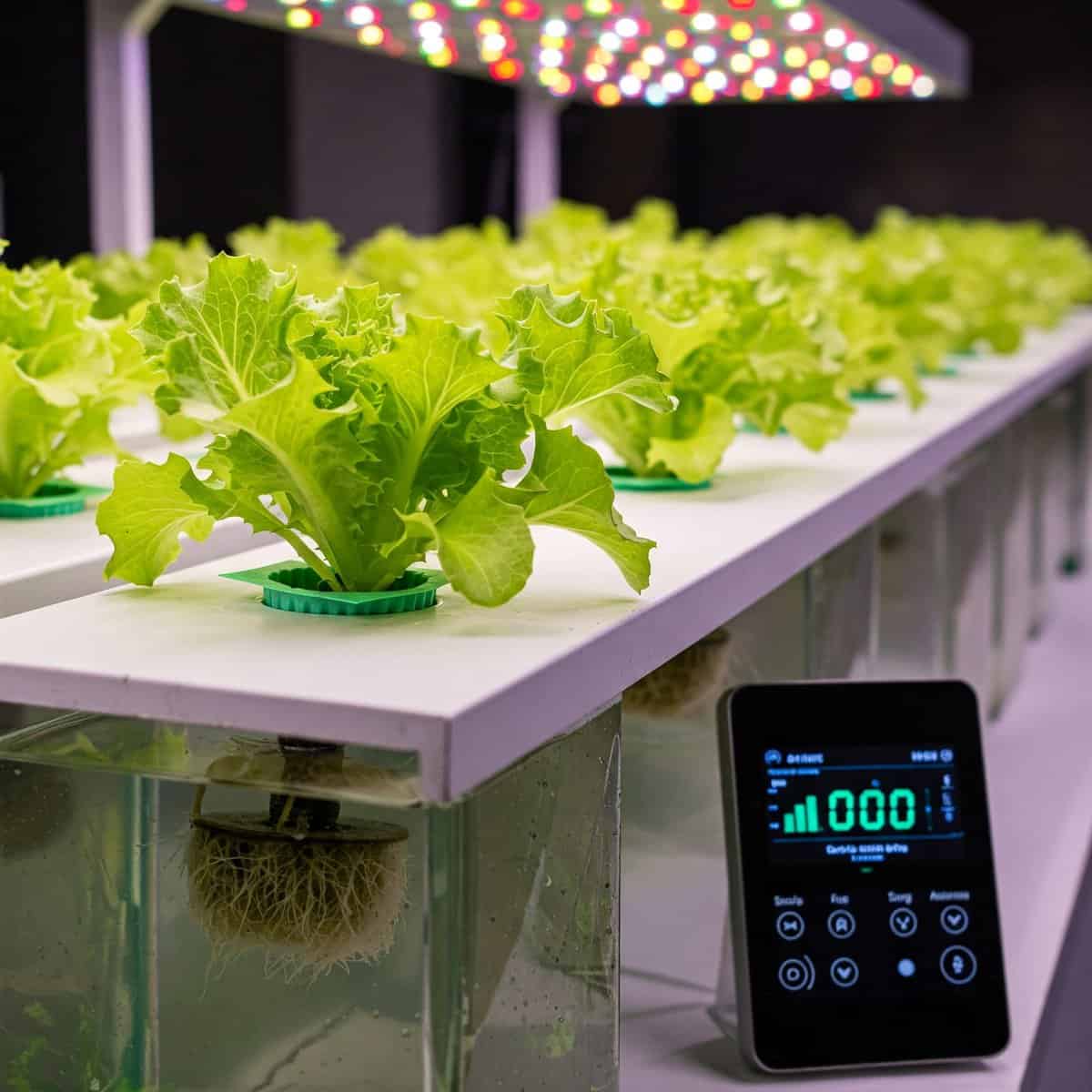Nutrient absorption in hydroponics depends on several key factors that can make or break plant growth. The right pH levels (5.5-6.5) and water temperature (65-75°F) create optimal conditions for roots to take up nutrients. Plants absorb nutrients 20% faster when dissolved oxygen levels stay between 7-10 parts per million.
A balanced nutrient solution, combined with proper electrical conductivity (1.2-2.4 mS/cm for most crops), ensures maximum uptake through the root system. Regular monitoring of these parameters helps maintain ideal absorption rates, leading to healthier growth and bigger yields. Keep reading to discover the exact steps for maximizing nutrient uptake in hydroponic systems.(1)
Key Takeaway
- Balance your nutrients to help plants get what they need.
- Keep an eye on the pH level to make sure nutrients are available.
- Adjust the flow of water to help roots grow strong.
Nutrient Solution Composition
Credit:By Hort Americas
Setting up a hydroponic system is like cooking a meal—get the recipe wrong, and the results won’t be as expected. Plants rely on a balanced nutrient solution, much like a multivitamin.
Macronutrients:
- Nitrogen (N): Essential for growth and green color.
- Phosphorus (P): Supports root and flower development.
- Potassium (K): Key for overall health, water regulation, and stress resistance.
Micronutrients:
- Iron: Crucial for chlorophyll production.
- Calcium: Strengthens cell walls.
- Magnesium: Supports photosynthesis.
The first time I mixed nutrients, I didn’t pay attention to measurements, and my plants suffered. With the right adjustments, growth was much faster. pH is critical for nutrient absorption—aim for 5.5 to 6.5. Keep experimenting, observing, and adjusting based on plant health signs.
pH Management
Plants have a hidden “scale” in their roots, determining if they thrive or struggle. Most plants prefer a pH between 5.5 and 6.5—just right for them. If the pH is off, nutrients get locked up and can’t be used.
- Too high or too low pH makes nutrients unavailable.
- When pH is too low, calcium and magnesium are blocked, leaving plants weak or yellow.
- When pH is too high, plants struggle to get iron, leading to yellowing leaves.
I had a similar issue with my plants—pale and sad despite watering and sunlight. A pH check revealed it was too high. After adding sulfur, my plants perked up in just a week.
- Regular pH checks (at least monthly) help.
- Use pH monitors for accuracy.
- Adjust pH by adding sulfur or compost to lower it, or lime to raise it.
Small changes can make a big difference!
Flow Rate Optimization
Watching water flow through a system that nourishes plants is fascinating. The right flow rate is crucial for root health. Here’s what I’ve learned:
- Too Fast: Water rushing over the roots compacts them, reducing air flow. This stresses the roots, and nutrient uptake is hindered. I’ve seen roots become tangled and unhealthy when the flow was too high.
- Too Slow: If the flow is too slow, some parts of the root system may remain dry. This can lead to root rot in stagnant water.
- Just Right: A balanced flow rate allows roots to spread and absorb nutrients. The roots grow freely and healthily.
The ideal flow rate depends on the system, but around 1-2 gallons per minute (GPM) works well in deep water culture (DWC). The right pace for water flow is essential for plant growth and root development.
Oxygenation
Plants, like humans, need oxygen to survive. It’s not just for breathing—it helps them grow, absorb nutrients, and fight off disease. The roots, responsible for soaking up water and nutrients, need plenty of oxygen. Without enough, they can become weak, and their ability to absorb nutrients drops.(2)
Here are some ways to boost oxygen levels for your plants:
- Aeration Systems: Use aquarium air pumps or more complex systems to force oxygen into the water.
- Oxygen-Rich Solutions: Add oxygen boosters or commercial solutions to increase oxygen in the water.
- Bubble Stones: Submerge these in plant containers to release small bubbles that boost oxygen levels.
- Watering Routine: Change the water regularly to avoid stagnant water and keep oxygen levels up. For plants in soil, aerate the soil occasionally.
Regular oxygenation can help prevent stress, allowing plants to thrive and grow faster.
Environmental Factors
Temperature affects plant growth by influencing nutrient absorption. Plants are sensitive to temperature changes, and small shifts can affect their metabolism, just like with humans.Consistency is crucial: Keep indoor plants between 65°F and 75°F (18 to 24°C). Extreme temperature fluctuations can stress plants.
Nighttime temperatures matter too. Avoid temperatures below 50°F (10°C) at night, as it can hinder nutrient uptake.Consider heat sources: Radiators, space heaters, or sunlight can overheat plants. Move them to cooler spots if they look wilting or crispy.The sweet spot for most indoor plants is around 70°F (21°C) for optimal growth and nutrient absorption.
Light is essential for plant health and growth. Without the right type and amount of light, plants can’t efficiently absorb nutrients.LED grow lights help with faster growth. Blue light promotes leafy growth, while red light supports flowering and fruiting.Keep LEDs 12-18 inches above plants for the best light distribution. Adjust them as plants grow.
Innovative Techniques
UV-C light, typically used for sanitation, can help plants grow faster, absorb nutrients better, and keep pests away.UV-C falls in the 200 to 280 nanometer wavelength range, strong enough to kill bacteria and viruses.Exposure to UV-C light triggers stress responses in plants, helping them produce antioxidants and compounds that fight harmful microorganisms.
Plants in UV-C environmentsr grow faster, absorb more nutrients, and show increased root growth.Some studies suggest UV-C light can enhance photosynthesis, helping plants make more food.The right balance of UV-C light can lead to healthier, stronger plants with better yields.
Exposure of 5-15 minutes per day is recommended for optimal effects without harming the plants.UV-C light systems are available for home use, and it’s important to start with low intensity and gradually increase exposure.Keep an eye on plant responses to avoid overexposure.
Conclusion
Nutrient absorption in hydroponic systems depends on precise management of multiple factors. The process requires balanced nutrient solutions (typically containing nitrogen, phosphorus, and potassium at 150-300 ppm) and stable pH levels between 5.5 and 6.5. Water flow rates of 1-2 liters per minute support optimal nutrient delivery.
Modern techniques like nutrient film technique (NFT) and deep water culture enhance absorption rates by 20-30% compared to traditional methods. Regular monitoring of these parameters leads to healthier plant growth.
FAQ
What’s affecting my plants’ ability to absorb nutrients in my hydroponic system?
Several factors can impact nutrient uptake. Your water temperature should stay between 65-75°F (18-24°C) since roots get sluggish outside this range. pH levels need to be just right – most plants like it between 5.5-6.5. Make sure you’ve got enough oxygen bubbling through your system, as roots need it to efficiently take up nutrients. Poor lighting can also slow down the whole process since plants need energy from light to power their nutrient absorption.
How can I tell if my plants aren’t absorbing nutrients properly?
Look for yellowing leaves (especially between the veins), stunted growth, or unusually dark green foliage. Your plants might show signs of nutrient deficiency even when there’s plenty of food available – kind of like being hungry at a restaurant but unable to eat. New growth might look pale or deformed, and older leaves could start dropping prematurely. You might also notice slower overall growth compared to your usual results.
Does water quality really matter that much for nutrient absorption?
You bet it does! Hard water can lock up certain nutrients, making them unavailable to your plants. Starting with filtered water helps nutrients stay dissolved and available for uptake. If you’re using tap water, let it sit out for 24 hours to let chlorine evaporate. High levels of sodium or other minerals in your water can interfere with nutrient absorption, so consider getting a water test if you’re having persistent issues.
How often should I change my nutrient solution to maintain good absorption rates?
Think of your nutrient solution like a carton of milk – it doesn’t last forever. Most growers change their solution every 7-14 days, but you’ll want to adjust based on your plants’ growth stage and system size. Keep an eye on your EC (electrical conductivity) readings – if they’re swinging wildly, it’s probably time for a change. Young plants typically need solution changes more frequently than established ones.
What role does temperature play in nutrient absorption?
Temperature acts like a thermostat for your plants’ metabolism. When your nutrient solution gets too cold (below 65°F), roots become sluggish and absorption slows way down. Too warm (above 75°F), and you’re creating a perfect environment for unwanted bacteria while reducing oxygen levels. The sweet spot falls between 65-75°F, where roots can actively take up nutrients without struggling against environmental stress.
Should I adjust nutrient concentrations throughout my plants’ growth cycle?
Yes, your plants’ nutrient needs change as they grow, just like a teenager needs more food than a toddler. Young plants prefer a more diluted solution to prevent overwhelming their developing root systems. During the vegetative stage, they’ll want more nitrogen-heavy nutrients. When flowering or fruiting, they’ll need higher levels of phosphorus and potassium. Keep tabs on your EC readings and adjust accordingly.
What’s the connection between pH and nutrient absorption?
pH works like a gatekeeper for nutrients. Different nutrients become more or less available at different pH levels. Most hydroponic plants prefer slightly acidic conditions between 5.5-6.5. Outside this range, certain nutrients become locked out – kind of like having a key that doesn’t quite fit the lock. Regular pH monitoring and adjustment helps keep nutrients available for absorption.
How does oxygenation affect nutrient uptake in my system?
Think of oxygen as your plants’ energy drink – without enough of it, they’ll get sluggish and won’t absorb nutrients effectively. Roots need oxygen to power the active transport processes that move nutrients into the plant. Make sure your air stones are working properly and consider adding extra aeration during warmer months when oxygen levels naturally drop. You can also space out plants to ensure good air circulation around the root zone.
References
- https://atlas-scientific.com/blog/nutrient-solution-for-hydroponics/?srsltid=AfmBOoqJTcKetrtdB1IckrNOmWbGOAiu_mKY_rEa8PKV_WW4A_QbBT1I
- https://puregreensaz.com/blog/hydroponics-nutrient-solution/
Related Articles
- https://tophydroponicgarden.com/hydroponics-for-beginners/
- https://tophydroponicgarden.com/plants-grow-slower-in-hydroponics/
- https://tophydroponicgarden.com/nutrient-film-technique/
Was this helpful?

I’m Barrie L., a passionate hydroponic gardening enthusiast dedicated to cultivating thriving, soil-less gardens. With a focus on all things hydroponic, I share my expertise on innovative growing techniques and sustainable practices through my blog, tophydroponicgarden.com. As a seasoned hydroponics specialist, my goal is to inspire and guide fellow gardeners in harnessing the power of water-based cultivation for bountiful and eco-friendly harvests. I’m also an author of the book “Hydroponics For Absolute Beginners: Your Step By Step Guide For How To Create An Hydroponics System At Home Without Soil, For Growing Vegetable, Fruit And Herbs.” which is sold on Amazon. Join me on a journey of redefining the way we cultivate plants, one nutrient-rich solution at a time. Happy growing!


